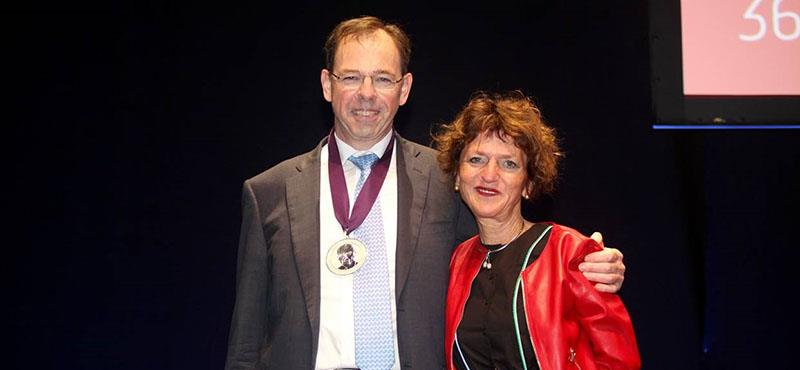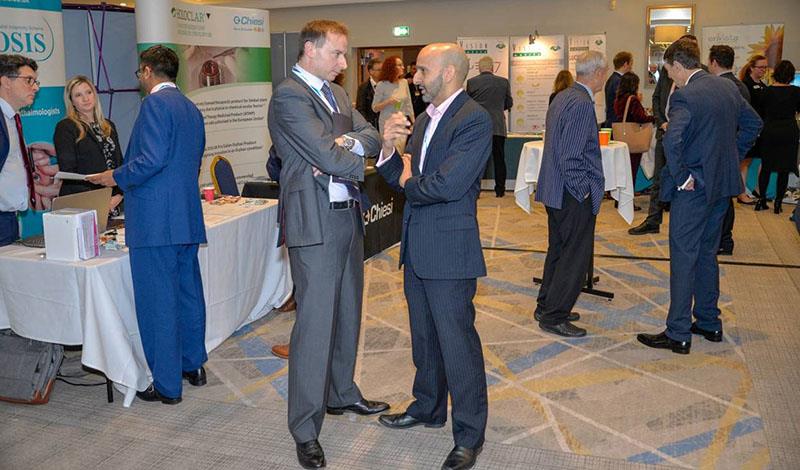The 36th Congress of the European Society for Cataract and Refractive Surgeons (ESCRS) took place in Vienna this year. It is arguably the leading international cataract and refractive surgery Congress, attracting more than 9,000 surgeons, optometrists, nurses, healthcare professionals, academics, manufacturers and industry representatives from 123 countries.
As Professor Béatrice Cochener, ESCRS President, pointed out at the opening ceremony, ‘The numbers tell their own story’ going on to say the Congress had 16 symposia, 572 free papers, 120 instructional courses, 77 wet labs, and a vibrant trade exhibition with more than 326 exhibiting companies.
At ESCRS Congresses, the latest technological innovations in cataract and refractive surgery are showcased and cutting-edge topics are discussed by panels of internationally renowned expert clinicians, vision scientists and other key opinion leaders. This year’s Congress saw the introduction of new features, such as a free paper forum, designed to facilitate greater interaction between presenters and their audiences.
A new initiative discussed was the European Registry for Childhood Cataract Surgery (EURECCA), headed up by Dr Marie-José Tassignon. This follows the hugely successful European Registry for Quality Outcomes initiative (EUREQUO) with EURECCA designed to improve surgical outcomes and quality assurance for surgery in infants and children.
The Ridley Medal lecture this year was presented by Professor Rudy Nuijts, Professor of ophthalmology at the University Eye Clinic Maastricht.
He gave an enlightening talk on evidence-based medicine. He pointed out that registries, artificial intelligence and advances in image analysis techniques can now all help to answer clinical questions more ably.
He illustrated the importance of combining clinical expertise with the best available scientific evidence by referring to examples of landmark collaborative studies in ophthalmology, including the ESCRS PREMED study.
This was the first international randomised controlled clinical trial focusing on the prevention of cystoid macular oedema (CMO) after cataract surgery. The main findings of this study showed that a combination of a topical steroid and non-steroidal anti-inflammatory was more effective at preventing post-operative CMO than either agent individually in non-diabetic patients.
Furthermore, a subconjunctival injection of triamcinolone acetonide given perioperatively in diabetic patients, signifi-cantly reduced the risk of developing post-operative CMO.

Professor Béatrice Cochener, ESCRS president with Professor Rudy Nuijts this year’s Ridley Medal recipient
In the refractive laser arena, Smile (Small Incision Lenticule Extraction) featured again this year. There were several presentations on the outcomes being achieved and the potential advantages of Smile over traditional laser vision correction approaches. These include less dry eye, less impact on corneal nerves and possible biomechanical advantages.
An update was also given on the results of clinical trials for hyperopia which appear encouraging and it is envisaged Smile should be commercially available for hyperopic patients soon.
The number of Smile procedures carried out is approaching two million, compared to around one million this time last year. Newer femtosecond lasers for refractive lenticule extraction are being developed – another indicator Smile is becoming an attractive alternative for patients interested in surgical management of their refractive error.
As always, a popular feature at ESCRS were the many wet lab opportunities for those interested in trying the latest cataract and refractive techniques, an option that was enjoyed by some of Optegra’s optometrists attending this meeting.
A highlight of the meeting was the inaugural ESCRS Heritage Lecture, delivered by renowned German surgeon and past ESCRS president, Professor Thomas Neuhann. Professor Neuhann’s lecture concerned the development and evolution of the capsulorhexis, a key part of modern cataract surgery.
The continuous, curvilinear capsulorhexis technique is the method used to open the anterior capsule to access lens material and represents an advance over previous methods.
During a clinical research symposium on myopia, Professor Caroline Klaver delivered a talk on the epidemiology of myopia. Risk factors discussed included genetics, more time spent indoors and less outdoors, as well as lower vitamin D levels. Professor Klaver relayed advice that can be given to children which was structured as a 20-20-2 rule. This consisted of 20 minutes of near work, followed by 20 second break looking in the distance and a recommendation of at least two hours a day outside.
There were several interesting sessions and courses on keratoconus and cross-linking. One session, led by a panel of experts including Professor Theo Seiler presented on the biomechanics of the cornea. As biomechanical asymmetry is noted in keratoconic patients due to focal areas of weakness, it was suggested that customised cross-linking could be more appropriate than ‘standard’ cross-linking approaches.
Presenters discussed options which include performing topography guided cross-linking, PRK (photorefractive keratectomy) or PTK (phototherapeutic keratectomy) with cross-linking.

UKISCRS exhibition area
As always, the ESCRS Conference never disappoints in terms of the sheer level of quality content available. There is enough to keep everyone interested, whether one’s focus is cataract or refractive surgery, myopia, dry eye, or cornea. Vienna was a wonderful city to explore outside of the conference and plans are well under way for the 2019 ESCRS meeting which will take place in Paris next September.
This year the 42nd Congress of the UK and Ireland Society for Cataract and Refractive Surgeons (UKISCRS) took place in Hinkley, Leicestershire, in November. An aim of UKISCRS is to promote education and research in the field of cataract and refractive surgery. It is a good mix of presentations, free papers, posters, workshops and exhibition.
The programme featured a Young Ophthalmologist session including tackling cataract in glaucoma and vitreoretinal considerations and uveitic cataract surgery. A plenary session on biometry covered the technical considerations and post-surgical management of ametropia in post-refractive surgery cataract patients.
Professor David Spalton presented the Rayner Medal Lecture Award entitled ‘IOLs: for better or worse’. Professor Spalton presented some of the issues he has been involved with over the years; good and bad.
These included posterior capsular opacification, newer hydrophobic IOL materials to avoid glistenings, IOL calcification, and developments in advanced technology IOL designs including extended depth of focus or ‘EDOF’ IOLs. The latter are designed to offer good distance and intermediate vision, with some compromise on near vision but less glare and halo type side effects compared to some multifocal intraocular lens designs.
A session on laser refractive surgery featured presentations on Smile Xtra (applying dye into the pocket to ensure better diffusion and crosslinking) to prevent corneal ectasia in thinner corneas and borderline topography. Dr Sheetal Brar concluded that although this is a promising modality further data is required to prove the benefits on cornea stabilisation.
Mr Patrick Condon, consultant ophthalmic surgeon, received the UKISCRS 2018 Lifetime Achievement Award and he gave a fascinating presentation entitled ‘How shakers and movers I had the privilege to know shaped my 50 years in ophthalmology’. He published papers on aspects of sickle cell retinopathy with Dr Graham Serjeant. He was instrumental in introducing IOL implantation, phacoemulsification and the first National Eye Bank to Ireland as well as establishing the Irish ‘Fight for Sight’. With Prof Michael O’Keefe, he also introduced Lasik to Ireland in the early 1990s.
Other topics included cataract surgery in glaucoma patients, performance of intracameral mydriatics and anaesthetics during cataract surgery, cost saving benefits of preventing complications during complex cataract surgery, long-term outcomes following refractive lens exchange, refractive lens exchange in high ametropia and microinvasive glaucoma surgery (MIGS).
The UK and Ireland Society of Ophthalmic Professions (UKISOP) meet as part of the Congress. This year the UKISOP programme offered workshops on a variety of topics including tomography, OCT, applanation tonometry, dry eye and biometry, case presentations and talks on acanthamoeba and how to set up clinical trials in ophthalmology. The UKISOP faculty includes representatives from optometry, orthoptics, ophthalmic nursing and imaging.
In summary, UKISCRS offers another great option for anyone interested in keeping up to date in cataract and refractive and next year will be held in October at the same venue.
Optegra Eye Sciences is the not-for-profit research division of Optegra Eye Health Care and is committed to the development of eye sciences and championing the latest innovations in eye care. This is achieved by partnering with leading UK universities in the research and development of the next generation of ophthalmic services and technologies. In addition, its Professional Partnership Programme of education and development with optometrists and opticians ensures the very best medical treatments are available to all.
